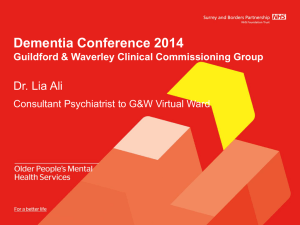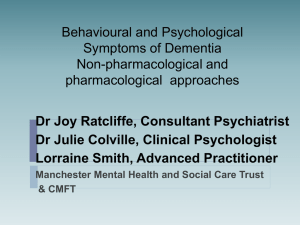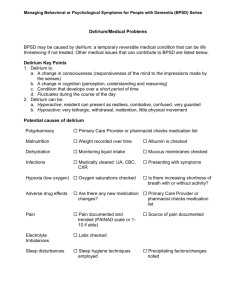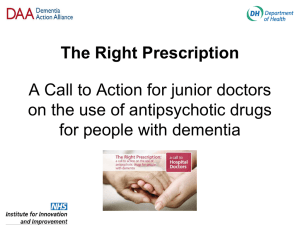Dementia Presentation
advertisement
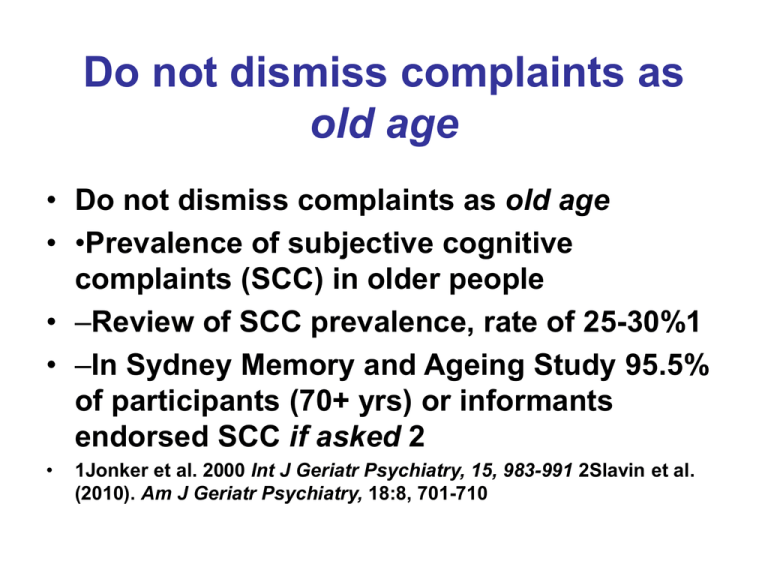
Do not dismiss complaints as old age • Do not dismiss complaints as old age • •Prevalence of subjective cognitive complaints (SCC) in older people • –Review of SCC prevalence, rate of 25-30%1 • –In Sydney Memory and Ageing Study 95.5% of participants (70+ yrs) or informants endorsed SCC if asked 2 • 1Jonker et al. 2000 Int J Geriatr Psychiatry, 15, 983-991 2Slavin et al. (2010). Am J Geriatr Psychiatry, 18:8, 701-710 What is dementia? • • • • • •An umbrella term to describe a syndrome •Usually progressive and irreversible •Over 100 causes 1.Alzheimer’s disease = most common 2.Vascular dementia (multi-infarct dementia; cerebrovascular disease) • 3.Lewy body dementia • 4.Fronto-temporal dementias • 5.Mixed AD and VaD, especially with old old age What is dementia – DSM5 definition • • • • Decline in > 1 cognitive function •Memory •Language •Executive abilities - planning, abstract thinking, organisation, conceptual shift • •Visuo-spatial abilities • •Impairs daily function: occupational or social • •Exclusion – solely delirium, some psychiatric conditions (depression = pseudodementia Prevalence of dementia • • • • • •> 6% of population > 65 years old •20% of persons > 80 years •30% of > 90 years old •In Australia 330,000 people w dementia •In 1000 GP practice, 200>65 10+ with dementia & >24 with pre-dementia (MCI) • –Approx. 2 new dementia cases per year Take history regarding cognition & function from informant •Clinical history • •Interview informant, assess carer needs • –See informant separately if possible • •Activities of daily living – dress, wash, toilet, teeth, shave • •Instrumental ADLs – cooking, shopping, meds, finance, transport, telephone, driving, safety • •More complex activities – bridge, languages 4. Assess cognition if any indication or suspicion of impairment •www.dementia-assessment.com.au • •MOCA • •GPCOG www.gpcog.com.au • •ACE III •If uncertain repeat over time Other frontal tasks • • • • • • Tapping –When I tap once, I want you to tap twice –When I tap twice, I want you to tap once •Explain proverbs – culture bias •Verbal fluency: FAS, animals •History – can’t follow movies, lack of anticipation, change in sense of humour, disinhibition, change in personality • •Interview – trouble understanding Mental state and physical examination • Look for specific conditions that mimic dementia (depression, delirium, drugs) or that can compromise cognition (eg cardiac failure, use of anti-cholinergic drugs) • •Check nutrition, hygiene, vision, hearing • •Check for causes of dementia • –eg hypothyroidism, B12 anaemia Investigate causes of cognitive decline • Rule out rare, but reversible causes eg Abnormal thyroid, calcium or Vit B12, tumour. Normal pressure hydrocephalus, infection • •See guidelines http://www.gpcog.com.au/files/investig ations.pdf Assessment: Routine Ix • • • • • FBC, ESR or CRP Clinical chemistry including calcium Thyroid function tests B12, folate CT scan of brain (without contrast) Investigations if indicated •ECG •CXR • EEG •micro-urine •fasting glucose, lipids •serology for HIV, syphilis •neuropsychological Ax •MRI •SPECT •PET scan Diagnose cause •Exclude depression and delirium • Diagnose type of dementia –Type of dementia •90% AD, vascular or mixed, then Lewy body and frontotemporal •Most pts. >80yo have mixed dementia (AD + VaD) Assessment - The Practice •History: crucial, especially from an informant •Onset: sudden (e.g. vascular), insidious (e.g. AD) •Progression: step-wise (e.g. multi-infarct dementia), gradual (e.g. AD). Assessment (cont’d) •Mental state examination - check cognitive functions of all lobes –Eg MOCA, ACE III, or GP COG •Physical examination including neurological, cardiovascular, endocrine Assessment - level and nature of current difficulties: •Abstract, complex skills e.g. following a plan, learning language • Instrumental activities of daily living (IADL), e.g. finances, telephone, transport • Basic activities of daily living (ADL), • e.g. dressing, washing, toileting. Behavioural and Psychological Symptoms of Dementia BPSD What are BPSD? •Agitation •Aggression •Calling out/ screaming •Disinhibition (sexual) •Night time disturbance •Shadowing •Swearing •Wandering •Depression •Anxiety •Apathy •Delusions •Hallucinations •Irritability •Elation/euphoria Why are BPSD important? •Ubiquitous, >90% of PWD during course • Distress to PWD and to caregivers •Increase rate of institutionalisation •Higher rate of complications in hospital Associated with: • Faster rate of decline • Increased mortality • Translating dementia Effects of BPSD •Residents with BPSD are more likely to (1): –be physically restrained –receive antipsychotic medication –negatively influence other residents •BPSD increase the cost of institutional care for persons with dementia (2) •BPSD, especially aggression (3) & calling out (4), increase nurse stress (1) Maslow K 1994; (2) O’Brien JA et al, 2000; (3) Rodney, 2000; (4) Draper et al, 2000 Aetiology of BPSD •Biological •Psychological •Interpersonal •Environmental The bio-psycho-social framework • • • • Socio- environmental Biological Psychological Interpersonal Biological causes - intrinsic •Frontal pathology (behavioural disturbance, disinhibition, depression) •Basal ganglia lesions (delusions) •Temporal lobe (delusions, hallucinations) •Locus coeruleus (psychosis, depression) •Chemical changes – serotonin, NA, DA •Genes – serotonin, dopamine receptors •Family history of psychiatric disorder Biological causes - extrinsic • Acute medical illness • Medication • Pain syndromes • Constipation • Sensory impairments • Fatigue • Fears • Basic needs (hunger, thirst...) • Psychiatric syndromes Before intervening … 1. Is the description accurate? 2. Identification of target behaviour 3. Does behaviour require intervention? 4. Careful diary of behaviours 5. Exclude non-dementia causes 6. Correct sensory impairment - hearing, vision Socio- environmental How to intervene: Environment •Modify environment rather than person •Avoid too much or too little stimulation •Adequate space •Privacy available How to intervene: Environment •Secure grounds •Personalised space •Non-institutionalised environment •Home-like •Colour, furnishings, architecture •Lighting •Resident mix •Size of residential facility Enhanced Environment Aroma therapy Lavender Lemon Balm moderate evidence from Cochrane review Pets, robotic pets, toys, dolls Family caregivers •Family carers as therapists for people living in the community •Systematic review –Effect Size = 0.34 for decreasing BPSD –ES 0.15 for decreasing caregiver “stress” • Brodaty H & Arasaratnam C, Am J Psychiatry, 2012 Dementia Care Mapping & Person Centred Care for agitation • Cost for PCC $6 to reduce a point on CMAI Chenoweth et al. Lancet Neurology 2009 Psychological approaches to BPSD •Music therapy •Snoezelen •? Sensory stimulation Livingston G et al Am J Psychiatry 2005; 162:1996-2021 • Useful during treatment but not long term Calming music and/or hand massage 10 min CMAI ratings before during immediately after Remington, Nursing Research, 2002 1hr after Novel strategies •Humour therapy •Volunteers •Music, singing, dance therapy •Integrating kindergarten/ babies Humor therapy: SMILE study •20% reduction in agitation •Effect size = antipsychotic medications for agitation •Adjusting for dose of humour therapy •Decreased depression •Improved quality of life • Low LF et al BMJ Open 2013 Brodaty et al Am J Ger Psych 2014 Low LF et al JAMDA 2014 Key elements •Engagement •Understanding •Time Barriers • Time • Money • Staff • Attitudes • Training Pharmacological interventions ChEIs & BPSD •Some benefit, statistically significant in some reviews but questionable clinical significance •Individual Sx may be more susceptible: apathy, hallucinations, aberrant motor behaviour, delusions, anxiety, depression •Trinh N-H et al, 2003 •Rodda et al, 2009 •Campbell et al, 2008 www.ipa-online.org Memantine on BPSD Mixed results –Several negative results 1-2 –Some positive results 3-4 • Specific benefits reported for cluster of • aggression, hallucinations & delusions • • • • 1 Reisberg B et al, 2003; 2 Van Dyck et al, 2007; 3 Tariot P et al, 2004 ; 4 Gauthier et al (2005), IJGP, 20, 459-464 Antidepressants •67 Sertraline, 64 placebo; 12 wk RCT + 12 wk •No between-groups diff. in depression response –in CSDD score –remission rates –secondary outcomes •SSRI associated > adverse events of diarrhoea, dizziness, dry mouth, pulmonary SAE (pneumonia) Weintraub D et al. Am J Ger Psych, 2010;18:332-340 Effects of citalopram on BPSD •Improve hallucinatns & delusions ( a’psychotics) •Improve agitation •60% ↓ irritability and apathy (but n.s.) •↓ hallucinations (statistical; ?clinical significance) •Prolong QT interval & worse cognition; < 30mg/d Pollock et al. (2002). Am J Psych 159: 460-465 Pollock et al. (2007). Am J Geriatr Psych 15: 1-11 Siddique et al. (2009) J Clin Psychiatry 70(6):915-918 Porsteinsson et al. JAMA. 2014;311(7):682-691. doi:10.1001/jama.2014.93 Anticonvulsants for BPSD 1 •Literature review of 7 RCT (2 carbamazepine & 5 valproate) •Results (treatment vs placebo): –1 study: sig. BPSD –5 studies: no sig. difference –1 study: sig. BPSD –AEs more frequent in treatment groups •Might be beneficial for some patients •Not recommended for routine use 1 Kanovalov et al (2008). Int Psychogeriatr, 20:2 Antipsychotics for … •Screaming X •Wandering X •Intruding into other people’s rooms X •Aggression ?√ (but not first line) •Delusions and hallucinations ?√ (but not 1st) Continuing vs stopping neuroleptics in dementia patients? •12 months RCT •Continuous use of neuroleptics vs placebo •For most AD patients withdrawal had no overall detrimental effect •Continuers – worse verbal fluency (p<.002) and higher mortality •Subgroup of pts with more severe symptoms might benefit from continued Rx Ballard et al 2008 PLOS Medicine, 5:587-599 DBMAS (dementia behaviour management advisory services) Clinical conclusions about management of BPSD Dr, Mrs Smith-Jones is hitting the nurses, disrupting the other residents and being impossible. Can you prescribe something?” “ Clinical practice 1 •Ask nurses to monitor behaviours – what, when, what happens before, during and after? •How often, when, what are precipitants? •Exclude pain, UTI •Determine cause •Correct reversible factors eg stimulation level •Start with psychological & environmental intervention(s) –except if urgent or sometimes concurrent –informed consent II: Understand the person - Don’t just label the behaviour •Why is this person behaving this way now? •Aetiological map management plan •Different approaches often together •Be creative •Document •Monitor outcome •Partnership with family/ carers Clinical practice 2 •No cause can be found or correctable •Try psychosocial treatments – not sure how? BPSD Guide on your app call DBMAS or local psychogeriatric team •Psychosocial treatment fail •Consider pharmacological treatment •1st need informed consent from patient or proxy (Person Responsible, Guardianship Act) •Start low and go slow Rx for BPSD - summary •Cholinesterase inhibitors – for apathy •Memantine - ?benefit for agitation/aggression/ delusions/ hallucinations •Antidepressants – citalopram, sertraline, venlafaxine, mirtazapine •Risperidone 0.5 - 2mg/day; modal = 1mg •Olanzapine 5mg/day, up to 10mg/day •Carbamazepine, valproate – titrate dose against response, SEs and blood level •Analgesic stepped approach Prescribing & Deprescribing Psychotropics •Review regularly –At least after 3 months –Trial reduction, monitor behaviours •Resident arrived from hospital on psychotropics –Find out why • –If primary psychiatric diagnosis eg Sz, BAD > seek psychiatric review –If not, trial reduction after pt. settled Summary … d’oh! •Drug treatments limited benefit and side effects – yet 50% on >1 psychotropic and 30% of residents in Australia are on antipsychotics • 90% of psychotropic Rx given without required consent1 •Psychosocial and environmental therapies beneficial –effect size > drug Rx Rendina N et al, IJGP, 2009 Summary … d’oh! •So why isn’t there more engagment? •Why is the knowledge not being translated into practice? –Training – too little? –Cost – too much? –Time – not enough? –Residents, families, system?? BPSD Conclusions •BPSD common •Prevent BPSD PCC, environment, titratestimulation, CG and staff training •Drugs have limited effects and AEs •Psychosocial treatments have evidence •Problem is implementation •Practical suggestions for working with facilities •Need policy recognition too – accreditation standards, government policy, research support BPSD Conclusions •Pharmacotherapy –modestly effective for BPSD –Prescribe judiciously –Need medico-legal informed consent –Start low and go slow –Importance of deprescribing –Review regularly, at least 3 monthly oTrial reductions •The adult brain weighs about 1.3 kg •Dementia shrinks it to 1/2 its usual size
